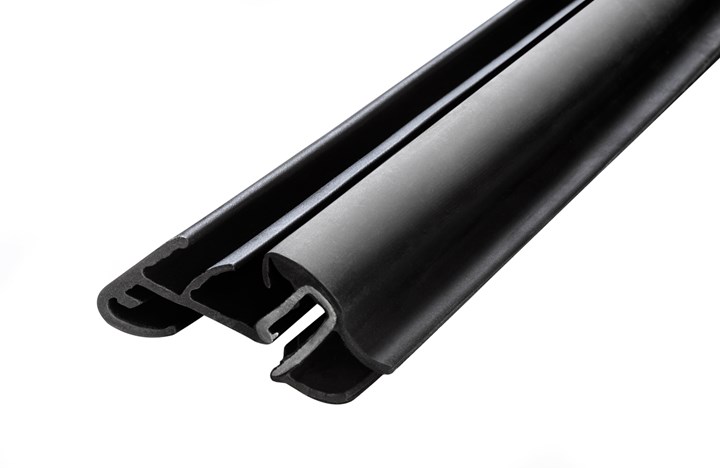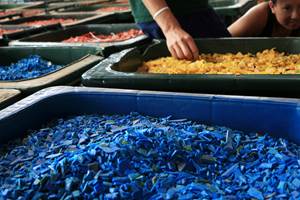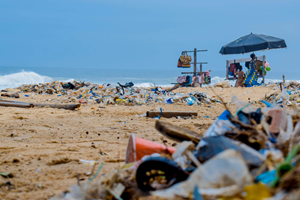Integrated TPV System Solutions Aid in Development of More Sustainable Automotive Weatherseals
ExxonMobil’s new Santoprene integrated TPV system solutions can potentially extend performance and recyclability while optimizing cost of GRC weatherseals.
Integrated thermoplastic vulcanizate (TPV) system solutions which have the potential to extend the frontiers of performance and recyclability while optimizing costs for glass run channel (GRC) weatherseals, have been developed by Houston-based ExxonMobil.

Commercially available Santoprene integrated system solutions are enabled by two new TPV grades which, when used together, are designed to replace EPDM rubber. Santoprene R² TPV includes post-consumer recycled (PCR) material, which is a major advance in the TPV arena, and Santoprene High Resilience (HR) TPV offers elastic recovery performance comparable to EPDM, which can be difficult to recycle. For other mechanical properties, both grades deliver a similar performance to EPDM.
Santoprene R² TPV can help improve its life cycle impact compared to regular Santoprene TPV, while offering an optimized balance of performance and cost-effectiveness for the foot element of the GRC. Santoprene TPV scrap generated during weatherseal manufacture can be melted and remolded, reducing the amount of waste. And, when a vehicle reaches its end-of-life, components made with Santoprene TPV can potentially be recovered and recycled, further contributing to the customer’s circular economy model.
Said ExxonMobil’s v.p. of specialty elastomers and butyl (SE&B) Dan Moore,“Initiatives like the EU Green Deal and CHINA VI are driving the automotive value chain to constantly consider how new sustainability objectives can be achieved. We are proud to build on our history of innovative solutions for the automotive value chain - working with Santoprene TPV, sustainability can now be instilled throughout the entire lifecycle of your vehicle,”
Santoprene HR TPV reportedly provides enhanced resilience, elastic recovery, and UV resistance for the lips and skins of the GRC. Frame-under-glass GRC, which are popular in Europe and becoming increasingly so in Asia Pacific, are typically made with a metal frame and EPDM. Due to its performance properties, Santoprene HR TPV is a viable replacement for EPDM rubber currently used for semi-dynamic weatherseal applications, plus technical and commercial tests are in progress for use in dynamic weatherseals.

“In the automotive weatherseals market, Santoprene TPV is acknowledged by the industry as being successful for static and less demanding semi-dynamic applications, while EPDM has been the material of choice for highly demanding semi-dynamic and dynamic seals. That is until now. The improved performance properties of Santoprene HR TPV, including resilience and elastic recovery, unleash the potential use of TPV as an EPDM alternative for more demanding dynamic applications,” said global SE&B market development manager Leslie Chan.
Added global SE&B product technology manager Jessica Vasquez, “In addition to the recycling potential, these system solutions support a reduction in weight for all types of vehicles by replacing metal reinforcement with PP and design flexibility. Material related vehicle weight constraints remain one of the challenges to achieving even greater energy savings.”

According to global SE&B auto market development manager Stephen Chan, commercial tests working with OEMs and Tier 1 suppliers are proving very successful, confirming that Santoprene HR TPV meets OEM specifications for highly demanding semi-dynamic weatherseal applications in a range of vehicles from traditional internal combustion engines (ICEs) to neighborhood electric vehicles (NEVs).
Related Content
At NPE2024, Follow These Megatrends in Materials and Additives
Offerings range from recycled, biobased, biodegradable and monomaterial structures that enhance recyclability to additives that are more efficient, sustainable and safer to use.
Read MoreHow to Optimize Color Evaluation of Recycled Plastics
The right color measurement instrument and good working methods will minimize variability in color evaluation of PCR.
Read MoreFungi Makes Meal of Polypropylene
University of Sydney researchers identify two strains of fungi that can biodegrade hard to recycle plastics like PP.
Read MoreDow, Circusil Collaborating on Silicone Recycling Facility
Dow and Circusil announced plans to construct a silicone recycling facility in Kentucky.
Read MoreRead Next
Beyond Prototypes: 8 Ways the Plastics Industry Is Using 3D Printing
Plastics processors are finding applications for 3D printing around the plant and across the supply chain. Here are 8 examples to look for at NPE2024.
Read MoreSee Recyclers Close the Loop on Trade Show Production Scrap at NPE2024
A collaboration between show organizer PLASTICS, recycler CPR and size reduction experts WEIMA and Conair recovered and recycled all production scrap at NPE2024.
Read MorePeople 4.0 – How to Get Buy-In from Your Staff for Industry 4.0 Systems
Implementing a production monitoring system as the foundation of a ‘smart factory’ is about integrating people with new technology as much as it is about integrating machines and computers. Here are tips from a company that has gone through the process.
Read More

























